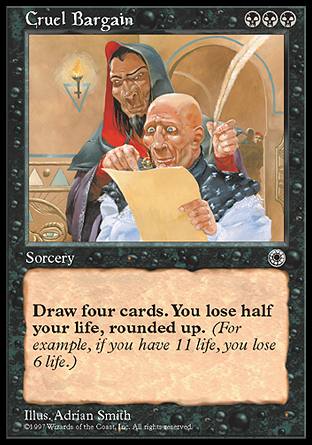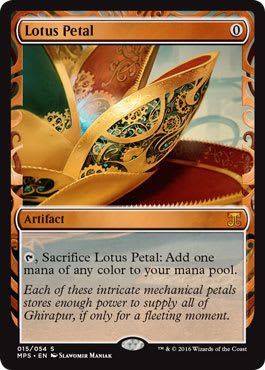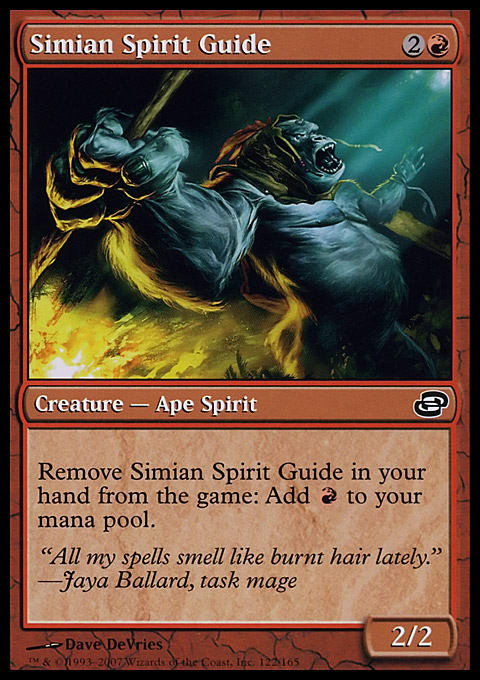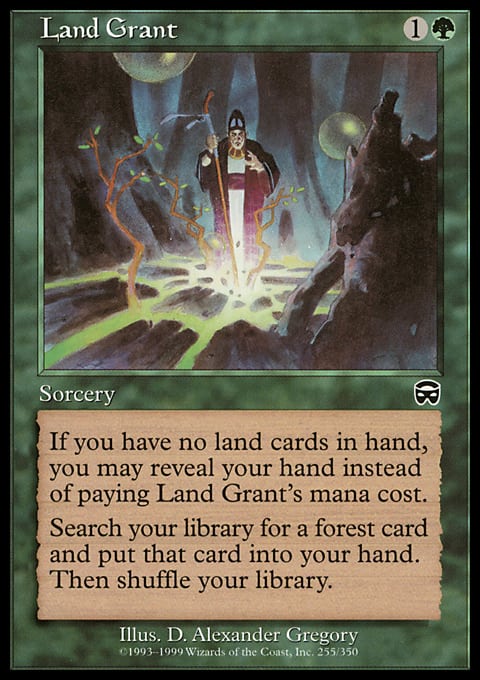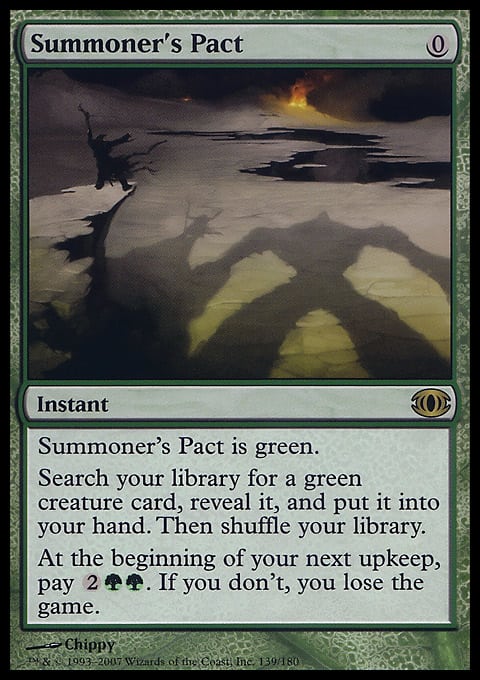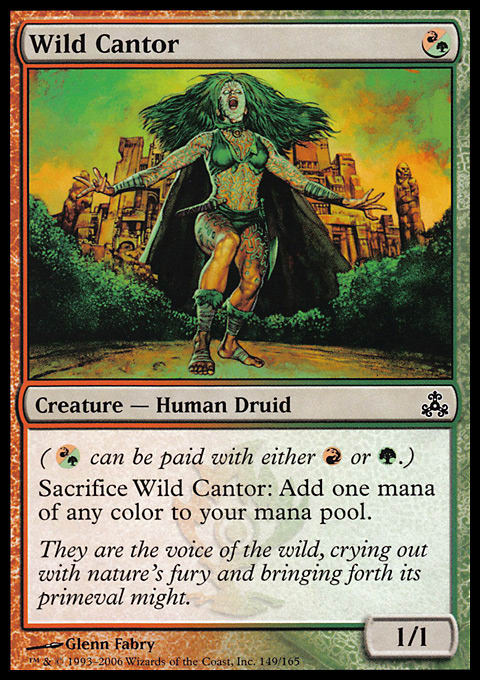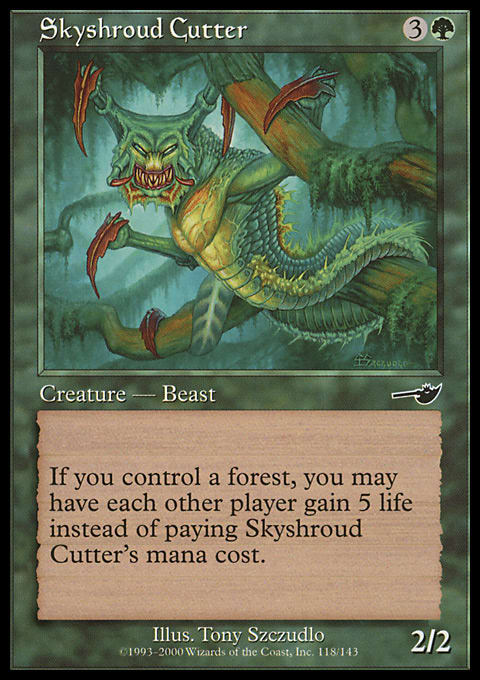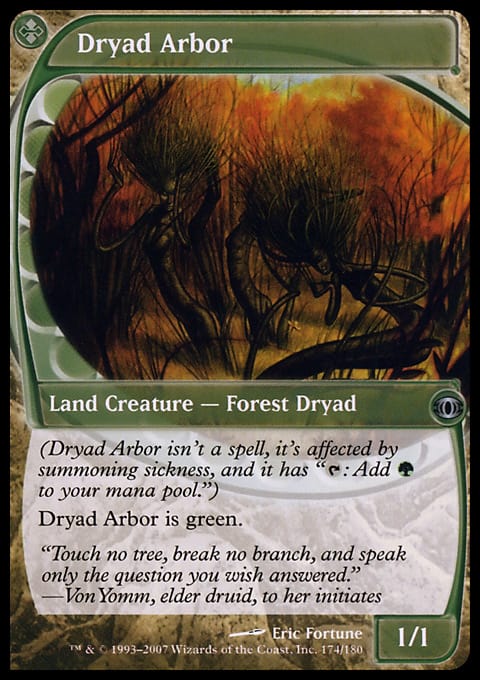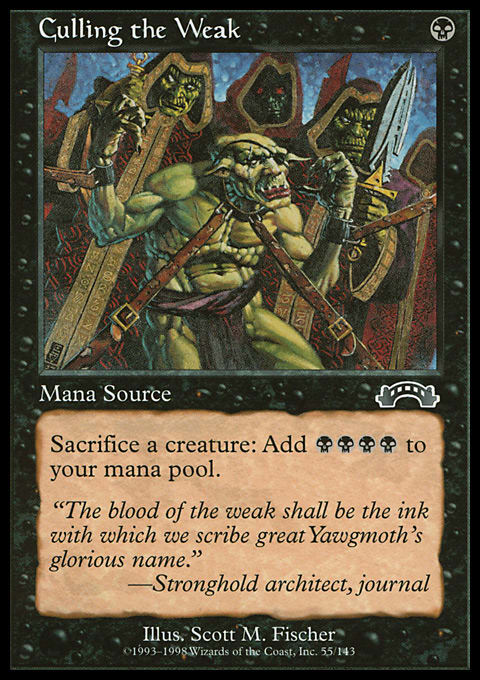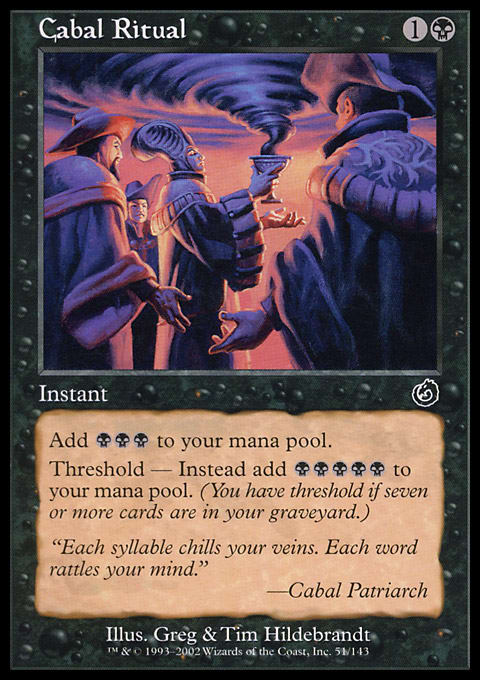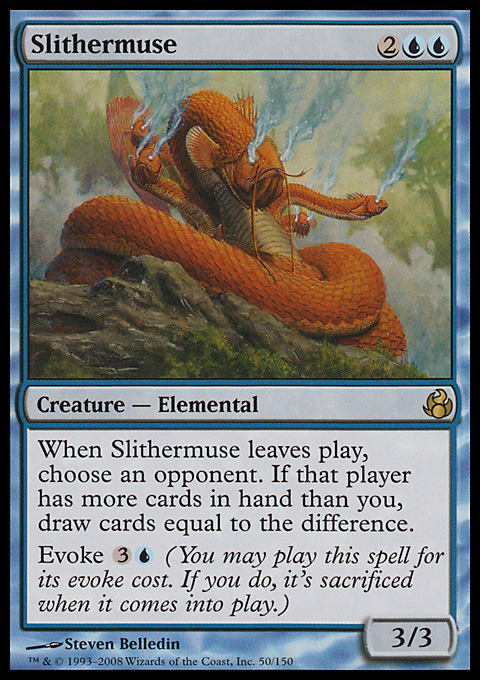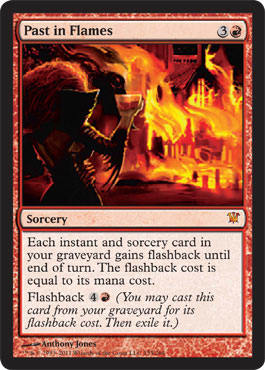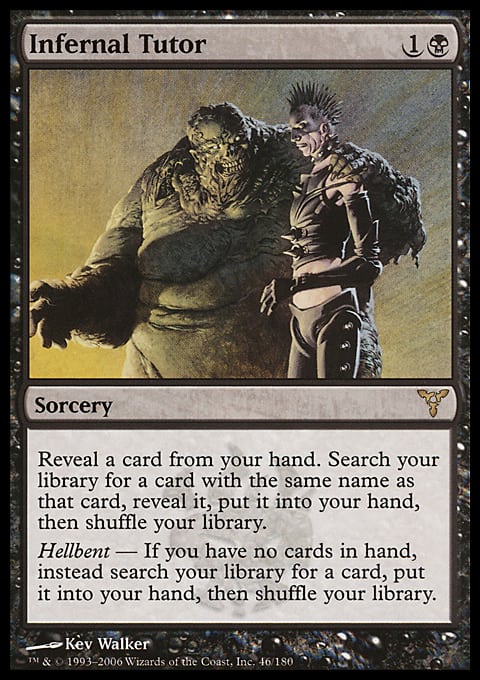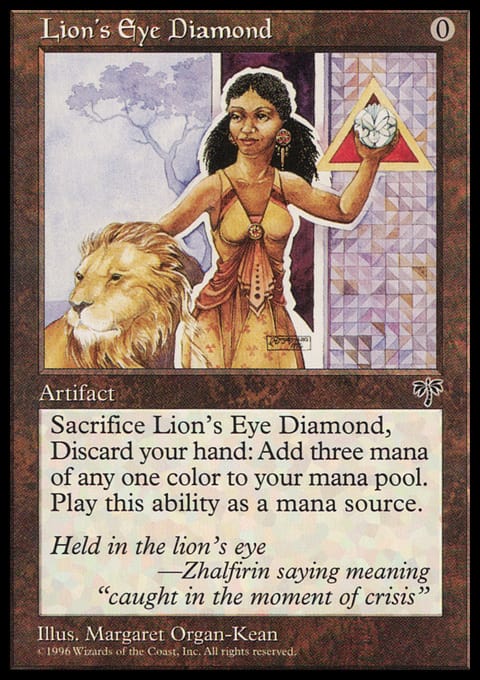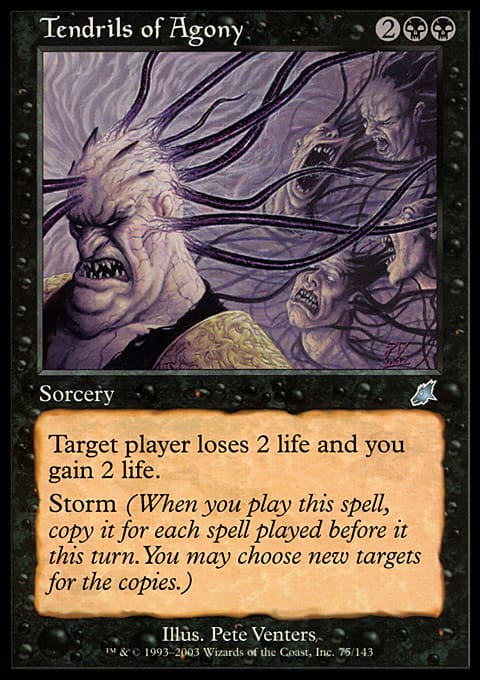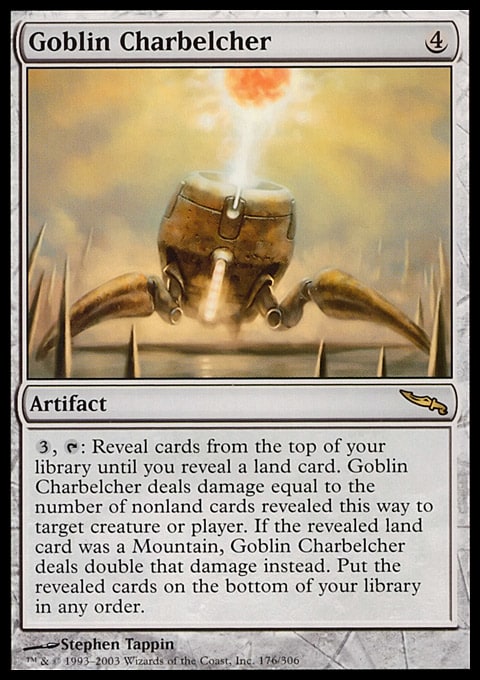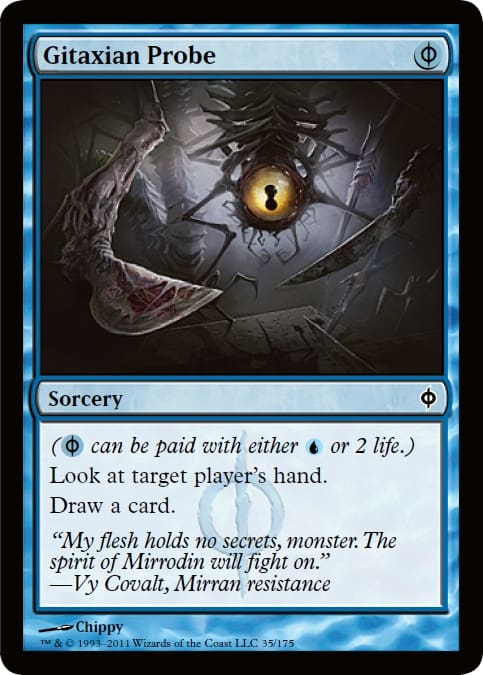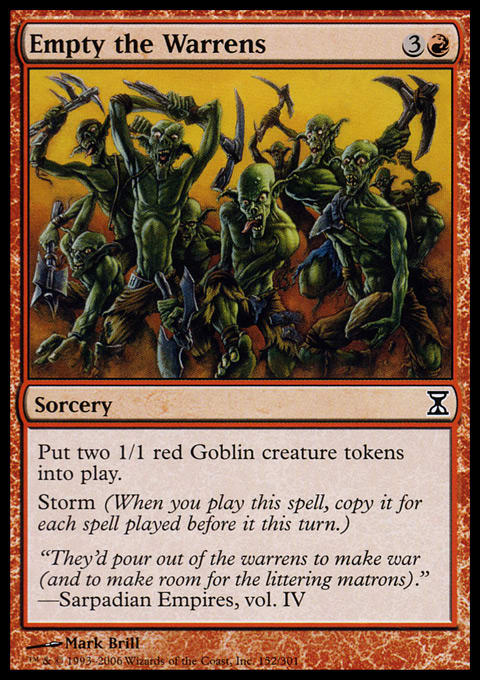Legacy is one of Magic’s deepest and most interesting formats. While there are some decks that are a bit more powerful than others, there are a variety of tier 2 and tier 3 decks that can be competitive if played well. Today we are going to take a look at one of these decks that has existed in the darkest corners of the Legacy format: The Spanish Inquisition.
At a glance Spanish Inquisition looks like a mashup between Goblin Charbelcher and more traditional Storm decks like ANT. However, it plays out in a fairly unique fashion and allows for a lot of interesting lines of play. Let’s take a look at a decklist, shall we?
Spanish Inquisition ? Legacy | Jeff Hoogland
- Creatures (8)
- 1 Simian Spirit Guide
- 1 Skullwinder
- 1 Skyshroud Cutter
- 1 Slithermuse
- 1 Wild Cantor
- 3 Elvish Spirit Guide
- Instants (16)
- 4 Cabal Ritual
- 4 Culling the Weak
- 4 Dark Ritual
- 4 Summoner's Pact
- Sorceries (20)
- 1 Past in Flames
- 2 Gitaxian Probe
- 2 Tendrils of Agony
- 3 Land Grant
- 4 Cruel Bargain
- 4 Infernal Contract
- 4 Infernal Tutor
- Artifacts (14)
- 2 Goblin Charbelcher
- 4 Chrome Mox
- 4 Lion's Eye Diamond
- 4 Lotus Petal
- Lands (2)
- 1 Bayou
- 1 Dryad Arbor
- Sideboard (15)
- 1 Autumn's Veil
- 4 Duress
- 3 Empty the Warrens
- 4 Leyline of the Void
- 3 Tomb of Urami
There is a lot going on in this decklist, so let’s break it down piece by piece. To start, let’s take a look at what makes Spanish Inquisition unique from the other fast combo decks in Legacy — the draw engine:
As someone who loves drawing cards, this deck is good at satisfying this desire. We often spend a good portion of our life total drawing more cards as we generate storm count and mana. Infernal Contract and Cruel Bargain allow us to recover better from mulligans and discard since they only require a small bit of mana to gas us back up.
Speaking mana — how exactly does this deck, with only two lands in it, produce mana? With a variety of “starters” we get our mana generation going:
All of these cards allow us to start generating mana just by playing them out / activating their abilities. Without one of these cards in our hand we have no way to start playing spells.
Summoner's Pact may seem like an odd card to list as a mana generator, but thanks to it fetching Elvish Spirit Guide, it is. Pay no attention to the upkeep cost on Summoner's Pact — Spanish Inquisition lives in the here and now. Unlike decks like traditional Charbelcher that often kill their opponent over a few turns with Goblin tokens, Spanish Inquisition gets its opponent dead the turn it combos.
That being said, this still leaves the question: why play Summoner's Pact over more Spirit Guides? The answer is utility. We play a small assortment of Green creatures to allow our Pacts to be flexible depending on what we need at a given point during our combo:
Wild Cantor acts as filtering for us, while also being a “free” means of increasing our storm count when we need to. It allows us to turn a Spirit Guide mana into Black, Blue, or Red depending on which payoff card or ritual we are looking to play. Skullwinder gives us a method to continue comboing when we have too much mana and not enough payoff cards. It can return Infernal Contract or Cruel Bargain to our hand to allow us to keep drawing cards and generating storm count. Skullwinder is played over something like Eternal Witness because a single Green is easier to produce than double Green.
Skyshroud Cutter and Dryad Arbor are cards that look fairly out of place in this deck until we make it to our rituals that produce multiple mana for us:
Culling the Weak is exceptionally powerful as far as rituals go and it is the reason for our odd Green creatures. It turns one mana into four which allows us to cast a draw four while still leaving a mana floating. Dark Ritual is probably the best ritual ever printed to date as it simply turns one mana into three without any extra work. Cabal Ritual not only generates extra mana for us, but also gives us a nice way to turn extra Red and Green mana into Black so it can be used to play draw fours.
Before we get to our finishers, we have a few other cards that allow us to continue comboing in tight spots:
Slithermuse often reads somewhere between draw five and draw seven cards in the first couple turns of the game. Past in Flames is a bit mana intensive, but it allows us to generate a large amount of storm by reusing all the rituals we already have in our discard pile. It also works well with Lion's Eye Diamond since we can use our Lion's Eye Diamond to make mana and then use that mana to flashback Past in Flames.
Lion's Eye Diamond is a really interesting card in general. Because it requires us to discard our hand to activate it, it is something we generally want to be using proactively. For example, common plays with LED include using it for mana in response to a draw four so that we can use the mana from it to play the new cards we will be drawing. Lion's Eye Diamond is also a combo with Infernal Tutor since it gives us a method to get ourselves empty handed so we can tutor up whatever card we need.
So once we draw a bunch of cards and generate a bunch of mana, how do we actually kill our opponent? We have two different ways for dealing lethal:
Assuming we generate enough Storm count we can simply play Tendrils of Agony for a lethal amount of drain. When we are going to try and kill with Goblin Charbelcher, we want to ensure both of the lands are out of our deck so that we know the activation will kill our opponent. Something to keep in mind with Charbelcher is that if we are a mana or two short from activating it the turn we play it, we can use it in response to our lethal Summoner's Pact triggers during our next upkeep after our Chrome Moxes and lands untap.
Sample Hands and Playing the Deck
Next I would like to take a look at how some of our games with Spanish Inquisition will play out. Every game with the deck is a puzzle where the goal is to get our opponent dead at the end. The deck is very capable of killing on turn one, with most games ending by turn three at the latest. Let’s take a look at some sample hands with Spanish Inquisition and talk through how they play out.
We are on the draw and keep the following six card hand:
We scry a copy of Lion's Eye Diamond to the top of our deck. Our opponent plays a land and passes.
- Draw for the turn.
- Pact for Elvish Spirit Guide.
- Pact for Wild Cantor.
- Play Chrome Mox imprinting Elvish Spirit Guide.
- Use Chrome Mox to play Wild Cantor.
- Make Black mana with Wild Cantor and cast Dark Ritual, then Cabal Ritual, then Lion's Eye Diamond.
- Cast Infernal Tutor, holding priority, and in response crack LED for Blue mana.
This leaves our mana pool with ![]()
![]()
![]()
![]()
![]() .
.
Get Slithermuse and evoke it to draw six cards. This leaves us with one Black in our mana pool. We draw the following cards:
- Cast Land Grant to fetch Bayou.
- Pact to fetch Skyshroud Cutter.
- Play Bayou and Cast Cutter for free
- Sacrifice Cutter to Culling the Weak.
- Cast Cabal Ritual.
- Cast LED.
- Cast Cruel Bargain with



 floating
floating
We draw:
- Cast Cabal Ritual.
- Use Lotus Petal to cast Past in Flames.
- Recast all of our rituals from our discard pile.
- Crack LED to discard our hand
- Cast Infernal Tutor from our graveyard
- Get Tendrils of Agony to kill our opponent.
Note we could also flashback a Pact to fetch our Dryad Arbor and then use tutor to find Goblin Charbelcher for lethal as well.
Whew! Let’s look at another, shall we?
We keep the following seven on the play:
- Cast Land Grant fetching Dryad Arbor.
- Cast Gitaxian Probe and draw Lion's Eye Diamond.
- Play Dryad Arbor
- Play Lotus Petal.
- Sacrifice Dryad Arbor to Culling the Weak.
- Cast Cabal Ritual.
- Cast Cruel Bargain with

 floating.
floating.
Draw four cards and now have the following hand:
- Cast Cabal Ritual to bring us to




 in pool.
in pool. - Cast Lotus Petal and LED.
- Cast Infernal Tutor and crack LED in response.
- Fetch Tendrils of Agony and cast it for a lethal amount.
Note if we wanted to go for style points here we can instead get Past in Flames and generate a much larger storm count before killing our opponent.
Let’s take a look at one more example. We keep the following seven on the play against an opponent who has mulliganed to six:
- Cast Chrome Mox and imprint Cabal Ritual.
- Cast Chrome Mox and imprint Summoner's Pact.
- Exile Spirit Guide for mana.
- Cast LED.
- Cast Infernal Tutor and crack LED in response for Blue mana leaving us with




- Fetch and evoke Slithermuse
We draw the following six card hand:
- Cast Summoner's Pact for Elvish Spirit Guide.
- Cast Lotus Petal.
- Exile our three Spirit Guides to add


 to our pool.
to our pool. - Crack Lotus Petal for black to cast Dark Ritual, we now have





 in our pool.
in our pool. - Cast Infernal Tutor while empty handed leaving



 in our pool.
in our pool. - Fetch and cast a lethal Tendrils of Agony.
Mulliganing
Because Spanish Inquisition is looking to end the game as quick as possible, the mulligans we make with the deck are often the most important thing in every game we play. Like I mentioned earlier, the fact that this deck plays eight draw fours means it mulligans better than most combo decks - do not be afraid to ship bad hands.
In general we are looking for three things in an opening hand:
- Starting mana
- Rituals to generate extra mana
- A way to draw more cards
Keep in mind when assessing our opening hands that Infernal Tutors with enough mana can turn into cards that draw more cards.
Sideboarding
Sideboarding with Spanish Inquisition is very straightforward. Our deck has one of a few “modes” post board. The first of these modes is just our main deck. If our opponent’s deck is not Reanimator or a Blue deck — shuffle up and present the same sixty cards we had for Game 1.
Against Reanimator we simply want to bring in our four copies of Leyline of the Void cutting 2 Gitaxian Probe, Skullwinder, and Goblin Charbelcher.
Against any deck featuring Blue cards, namely that pesky Force of Will, we pivot post board to have a slightly different game plan. Specifically, playing Summoner's Pact against a deck that can counter our draw spells and win conditions is normally a recipe for disaster. Because of this, we want to trade out these cards for some of our own disruption and a higher density of win conditions:
Both of these cards allow us to “go off” on turn one with a lower density of cards and then kill our opponent over the course of the next few turns. When we are going with this creature plan we board in everything except the Leyline of the Voids cutting:
Wrapping Up
Playing around with this Spanish Inquisition deck is the most fun I have had playing Legacy in a long time. As a person who enjoys math and puzzles, this deck really scratches an itch that most other Legacy decks do not. While playing long intricate games of Magic is often fun, sometimes playing Magic in short bursts and always having time to get lunch during an event is also a good time.
Have any questions about the Spanish Inquisition that I did not cover above? Let me know in a comment below! Also if you would like to see some videos of this deck in action — check out my Twitch stream archive on my YouTube channel here.
Cheers,
—Jeff Hoogland














